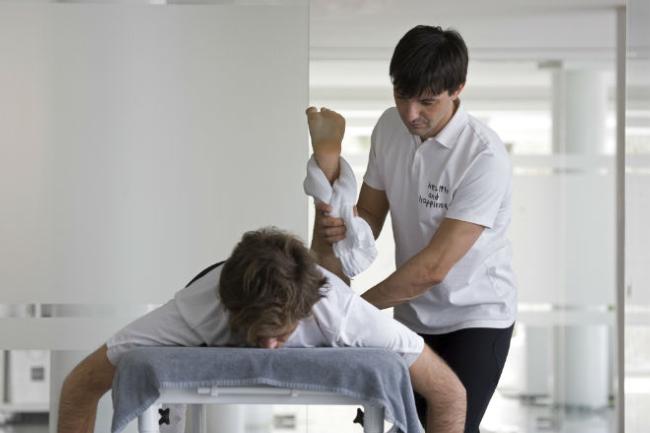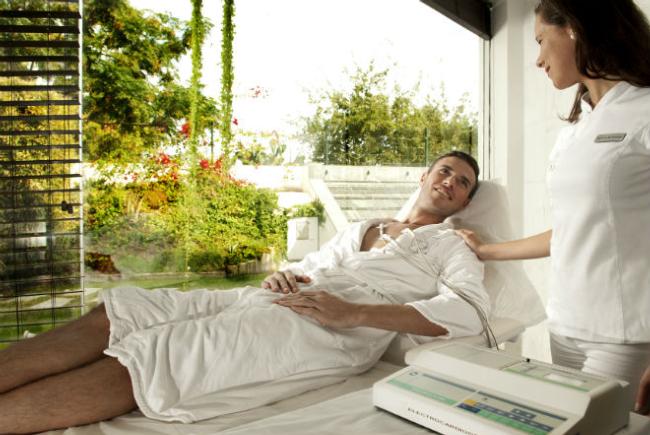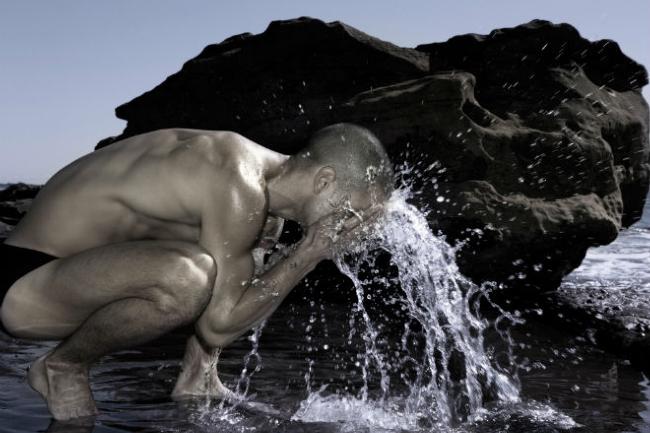Man in the Mirror
Published
04th Jun 2013
![Man in the Mirror]()
It’s no secret that the male grooming market is growing. Recent figures from research and consultancy company the Kline group show that, the recession not withstanding, international sales of male grooming products rose by nearly 4% in 2012.
Meanwhile, data from Euromonitor International reveals that the global male grooming market grew by an average of 6% between 2006 and 2011, reaching £22billion in 2011. Studies such as a 2011 Travelodge survey that found that for the fi rst time to date men now spend longer on personal grooming and getting ready than women, 81 minutes a day compared to 75 for women, also confirm this trend.

A growing market|
This development is one that spas, salons and product houses around the world are not only aware of but are increasingly tapping into, introducing treatments and product ranges specifically for men. “The men’s grooming market has had a buoyant few years, proving itself to be largely recession-proof with sales growing across most sectors,” says Amanda Lintott from Mintel. Pat Strutt, managing director of Ahava UK, which last year re-launched its Ahava Men range, says the range was initially introduced as a result of strong customer demand. “This is such a big growing market worldwide, in leaps and bounds,” she says.
Elaine Bryant, UK training manager for French skincare label Yon-Ka, which launched its Yon-Ka for Men range six years ago, echoes the view that there has been a noticeably increased demand for products for men.
“We launched the brand to meet the demand from the general consumer, because everyone was asking for a male-only brand,” she says. Clare Matthews – co-founder of Vitaman, an Australian natural grooming range for men that, established in1999, was one of the first skincare brands in the world dedicated exclusively to men − adds that “over the past 14 years, there has been a drastic rise in the market.”
Geraldine Howard, co-founder of Aromatherapy Associates, which has worked with male shaving and skincare brand The Refinery since 2000 and whose collaboration with the brand also includes a number of treatments developed for men, agrees that this is a burgeoning market, full of potential. “Male spa-goers are a constantly growing factor and the demand for men having facials has grown enormously, hence why we have designed specific treatments for them,” she says. “Our male customer base is growing all the time, particularly in spas.”

The medically focused Sha Wellness Clinic in Spain last year introduced a male rejuvenation programme incorporating mesopeel and mesotherapy treatments and Alejandro Bataller, vice president of sales and marketing, says that while Sha still sees a majority of female guests, 54% compared to 46% men, the gap is rapidly closing.
“The percentage of men who come here has increased by 10% in the last two years,” he says. “We realised that more and more men are coming to places like Sha, not only in search of relaxation but for aesthetic treatments and that they normally have different treatments to women,” he explains of the clinic’s decision to introduce a programme tailor-made for men.
Kirsty Hughes, spa manager at the spa at The Vineyard Hotel in Berkshire in the UK – which recently began offering Vitaman products and treatments – similarly reports a rise in the number of men visiting the spa. “During the week, our spa guests are probably still about 80% women but during the weekend, when we have a higher percentage of hotel guests, it’s more like 50/50,” she says. “I would definitely say that the percentage of men having facials has increased. Product pickup is still slower among men, but they are having more facials.”
Mia Mackman, president of the Arizona Spa & Wellness Association, says that the number of US spas catering for men with dedicated treatments or packages is also on the up. “With the continued growth in the men’s market, we are seeing these treatments and programmes rapidly increase, not just in Arizona but across the entire country,” she says. “Over the past eight years, we have seen tremendous growth in the number of services offered to men.”
Social change
It is generally agreed that the boom in the male grooming market, manifested both in a global rise in product sales and an increase in the number of men visiting spas, is a consequence of shifting social attitudes and a greater acceptance of men taking pride in their appearance.
“The growth in the male grooming market is down to a shift in perception; male grooming is now regarded as the norm” According to Lintott: “A renewed interest by men in personal grooming and a change in social attitudes towards male vanity have been at the heart of the industry’s growth.” Matthews says of the change that: “In existing major market like Europe and the US, it’s become much more acceptable for men to buy grooming products.”
This is a view that Howard backs up, commenting that: “I believe that the growth in the male market is down to a shift in perception, male grooming is now regarded as the norm, with men no longer raiding the bathroom cabinet and sneakily using their partner’s products,” she says.
Susan Jaffer, marketing director for intense pulsed light (IPL) provider Ecolite, says the brand has recently seen a significant upsurge in IPL treatments for men and puts this down largely to it becoming more socially acceptable for men to have hair removal or other aesthetic treatments.
“In the last 18-24 months, we have seen an increase in the demand for men to have the treatment,” she says. “It’s not that they were not having it before, but there was more of a taboo around admitting that you were having a hair removal or acne-based treatment, as a man.” Hughes attributes this noticeable development to media influence. “The celebrity factor is important, the fact that men are seeing celebrities promoting that they are using men’s products,” she says.
Another reason men are now more willing to sign up for treatments, such as facials, that were previously viewed as the reserve of women, is that they are more in tune with the concept of spa in general. “Men are now more used to spas,” Hughes says. “They start off having a massage and then they try a facial or something different. Once they are familiar with spa treatments, they’re more willing to expand the type of treatments they have.”
Strutt adds that the same principle applies to products, with men more willing to branch out and try the brand’s ordinary range, once they have familiarised themselves with the Ahava Men collection. “Once they’re comfortable using the men’s products, they’re quite happy to incorporate the use of other products as well,” she explains.

The male client
While experts say that treating male clients in a spa environment is no different from treating female clients, with the key remaining to find out what the customer is looking for and delivering that, men’s priorities and requirements are different. Hughes explains that, for this reason, it was important for The Vineyard to bring on board products and treatments developed specifically for men.
“We went with Vitaman because it’s a special range just for men, not just an add-on range for a product house,” she says. “Men’s skin is different, largely as a result of the fact that they shave their face, which is why we wanted a range fully designed for their skin.”
Commenting on the difference between men’s and women’s skincare needs, Howard also says that shaving is the main variance. “Shaving is the key difference. It can be quite damaging to skin, particularly for those who naturally suffer from sensitive skin, so it’s important for men to keep their skin in good condition; nourished and hydrated.”
Matthews adds that lifestyle can also play a part in men’s skin differing from women’s. “Looking at Australia as an example, men spend 65% more time outside than women, hence their skin is exposed to the elements much more, which results in more dehydrated, aged and wrinkled skin,” she says.
Jaffer explains that while IPL works just as well on men as it does on women, the nature of men’s skin means the treatment process could take slightly longer. “Therapists just need to be aware that with men, a higher number of treatments might be required, because the hair is stronger, there is more hair to work with and testosterone is quite strong,” she says.
Not only do men have different skincare needs, they also have their own preferences and concerns, reflected in the type of treatments they opt for and how they would like those treatments carried out. “Men like stronger pressure during massages, they generally like firm massages and are disappointed when the pressure is too soft,” Matthews says.
Javier Vázquez-Illa, clinic and spa manager at the Sha Wellness Clinic, says that men come to the clinic for slightly different reasons than women. “Men are more worried about stress than women and they require more deep tissue massages, while women prefer treatments such as body wraps.”
When it comes to the products proving most popular with male customers, Matthews reports that for Vitaman it is the face and shave categories that top the list (the brand also offers body and hair ranges) while Bryant comments that for Yon-Ka for Men, the cleanser, scrub and protection cream have all proved very popular. Meanwhile Strutt explains that, for Ahava, some regional differences have emerged.
“Our deep cleansing gel sells very well in the UK, but our German distributor finds that she cannot sell the deep cleansing gel to the German male population. Conversely, up until the last 18 months, it’s been very hard for me to sell hand cream in the UK, whereas the hand cream has always sold in Germany,” she says. Looking to the future, Strutt says that for Ahava, the male market is “something we seriously look at and seriously promote. It’s definitely a growing market.”
Enforcing this view, Jaffer comments that: “The male market is growing every day, we know that and the fact that we get so many clients asking about treating men shows that their customer are also asking them about it.”





